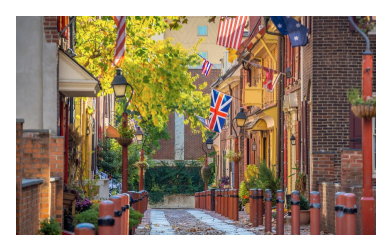Contact Information
Elfreth's Alley
124-126 Elfreths Alley
Philadelphia, PA 19106
United States
Elfreth's Alley Historic District and Museum
Elfreth's Alley Historic District and Museum

Elfreth's Alley is a miraculous survival: a narrow street of small houses, built between 1720 and 1836, which have been continuously occupied since Pennsylvania was a colony.
The alley was created in 1702-1704 by Arthur Wells and John Gilbert, owners of adjacent lots on Front Street. They ignored one of the most visionary aspects of William Penn’s 1684 plan for Philadelphia: the combination of wide streets and enormous blocks, which the founder hoped would induce his settlers to build large houses surrounded by gardens—and thus create a “greene country towne.”
Wells and Gilbert did otherwise. Between their properties, they laid out a narrow cartway that ran from Front to Second Street, an arrangement that allowed the interior of the block to be developed with small rowhouses. This profitable model was adopted for building throughout the city, creating Philadelphia’s distinctive plaid pattern of “big streets” and “little streets.”
The street only began to be called “Elfreth’s Alley” in the middle of the eighteenth century, named for blacksmith Jeremiah Elfreth, who owned several houses at its west end.
The oldest houses, built in the 1720s-1740s, are only two stories tall, with thick profiled details and narrow “pent roofs” sheltering the first floor windows and doors. The next generation of houses is one story taller, with thinner Federal style detailing, while early nineteenth century houses show traces of the rectangular discipline and marble trim of the Greek Revival.
Most of the historic residents of Elfreth’s alley were trades people; a potter, blacksmith, bricklayer, mason, dressmaker, and distiller are recorded as living here. Some also used their houses as workplaces. But they were not isolated from the intellectual and political diversity of the city. Benjamin Franklin surely frequently no. 122, the home of William Maugridge, one of the founding members of Franklin's “Junto,” a club devoted to discussing the issues of the day.
This remarkable piece of living history is safeguarded by the Elfreth's Alley Association, founded 1934, which operates a small museum at nos. 124 and 126.